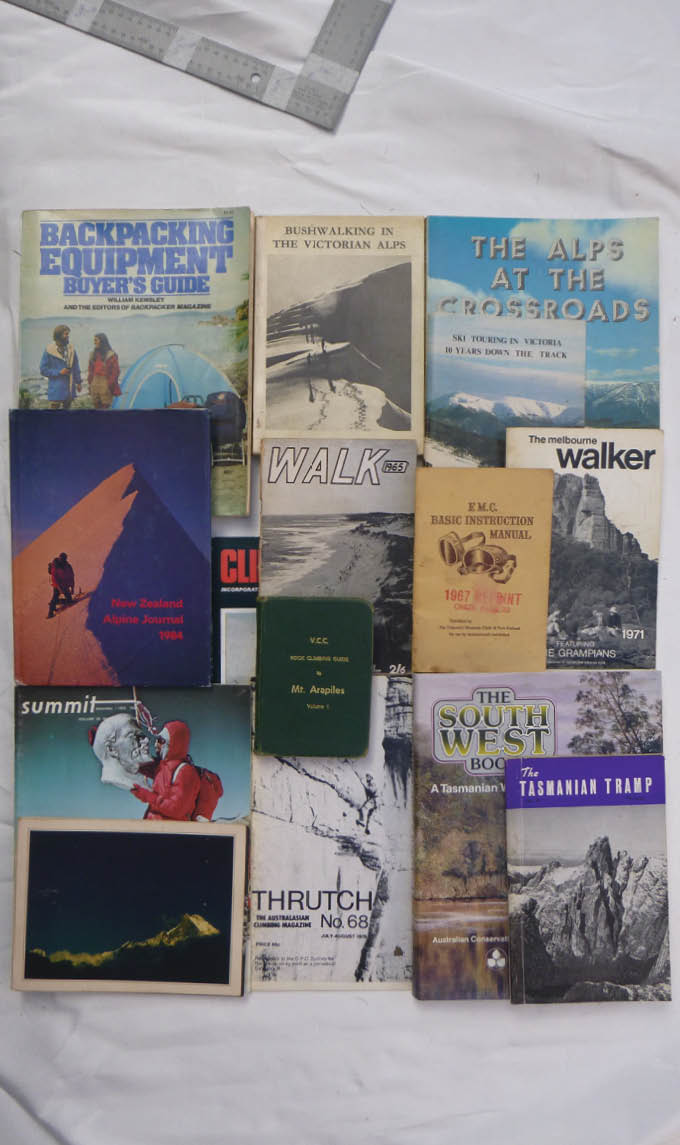



A few weeks ago I was rearranging the dust in the lower dungeon when I found a number of old publications. As I browsed through them I thought that many things have changed in 50 years. There are perspectives that may be interesting, with younger people probably not knowing some aspects.
All pictures and scans by Stephen Lake



Archive - Glimpses of the Past
Stephen Lake

48 | BWA June 2021
Rock1965 - VCC Rock climbing guide to Mount Arapiles volume 1This VCC guide has just 107 climbs. The preface says "Four years ago a most important step in Victorian climbing was taken, the first comprehensive guide to climbing in Victoria was produced." The 1965 Arapiles guide is "the first bound and printed guide book on rock climbing in Australia."
The grades have the English system, Moderately difficult to Hard very severe, grades 3-17. Improvements and developments in skill, technique, fitness and gear have led to grades of over 30. Some aid climbs (then called mechanical) are now free. For example, Dramp was graded severe/12 M2 in the book and is now grade 21. Some of the grades have gone up, perhaps due to the rock becoming smoother with climbing traffic.
A rope length of 120 feet (36.6 metres) was considered adequate. Today ropes are 60 metres long. In the early 1970s, ropes took just a few leader falls before they were risky. Now a rope can take 5-12 leader falls, and a lot more for people seconding or just above protection. In 1965 ropes were laid; now they are kernmantle.
Some of my guidebooks and other publications of that era have stamps and advertising from bushwalking shops now long gone – Bushgear, Moloneys and others.
1976 July-August – Thrutch 68 The Australasian climbing magazineThe cover has Reg Marron on the second free ascent of Odysseus at Bundaleer, Grampians, Victoria. Reg is now a magistrate. There's a report about a confrontation between conservationists and miners at Freycinet National Park – the miners want the rock. Grades have gone up to 22. Thrutch is now published by the Sydney Rock Climbers.
1976 October – Climber and rambler This is a UK magazine similar to Wild and is now called Climber. The only pack in this edition that was popular in Australia is the Cyclops Roc. A sleeping bag review lists bags that are good to -10 °C. These weigh 1.1-1.6 kilograms, a bit heavier than today. A lightweight tent is advertised … 5.52 kilograms. The colours are approved by the National Trust. There's an advertisement for a gadget with a siren audible at 900 metres and a light that goes to 280 metres. Ear muffs and sunnies are not included. Another advertisement has rocket flares. A pack called a Trojan looks nothing like the ones I have seen.
1976 November- December - Thrutch 69 There's an advertisement for the Omnipotent, a quantum leap in tent design. This tent has four hoops and needs just two pegs, quite different to the more common ridge tents and the Blacks Good companion style. The Omnipotent has a cited weight of 5.5 pounds, 2.5 kilograms, but this does not
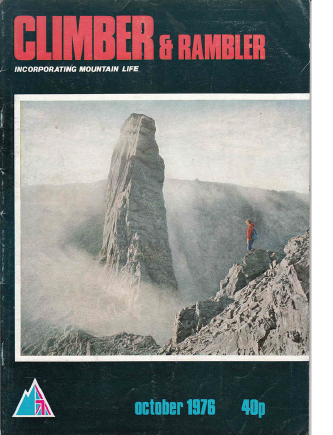

Omnipotent Source: oregonphotos.com

BWA June 2021 | 49
include the vestibules, essential in my view, so allow around 2.8 kilograms. The concept is good but it was hard to negotiate the end guys to get in or out. This amazing tent has now been surpassed by better designs.
The last page has a report of the first climbing death in Australia. This was in the Blue Mountains where a climber was unroped at the top of a pitch, and seems to have got too close to the edge where he slipped on loose rocks.
1977 May – Climber and ramblerTents have ridges, with just one tunnel tent, for expeditions. A pack in an advertisement is in sharp contrast to modern packs. The Haston Alpiniste has an elegant design, a single bag with a pocket in the lid. Modern packs are too complicated for me. Gas stoves are mentioned. A report of a 1937 trip says "We had scrounged a few clinkers for our army boots, our hemp rope had been carefully tested to prove that it would bear our weight, and we even had ice axes". Not many people know that the patterns on the soles of bushwalking boots are based on star muggers, clinkers, Tricounis and hobnails.
1994 – A rock climbers' guide to Arapiles/DjuriteThis guide is just over twice the size of the 1965 guide, 205 X 150 mm. A colour cover, more pictures (some with females climbers), better topos, lists by name and grade, and better descriptions are the changes since 1965. Forgot – there are over 2000 routes in the book, and in 2021, over 3000. This is before sections of Arapiles were closed. The hardest grade in the book is 32.
Gear1975 – Great Pacific Iron Works catalogueThis is a rather elegant booklet, with history, philosophy and other useful information and a lot of good pictures. The emphasis is on clean climbing, no pitons, somewhat ironic given that chalk was later used. The Chouinard krab is 71 grams, much lighter than steel. Hexentrics are three years old. "By the summer 1975 the minimum UIAA requirement will be increased to three falls." That is, a rope can take three falls safely. I was amazed to read that Jumars were invented in the early 1950s. Dachstein mitts are very heavy and quite warm, but take an age to dry.
1977 – Backpacking equipment buyer's guideThis is a substantial book, 285 pages. Despite the emphasis on American gear unsuitable for Australia, especially packs, this is an excellent guide. For example, the sleeping bag sections describe slant wall boxes, offset seams, mummy, rectangular and much more technical descriptions in 14 pages of words and diagrams before the reviews start. It's very hard to compare these bags with contemporary equivalent bags.
Tents have forest, rain, tropical, wind, Arctic tundra and desert tents categories. Wow. What seems to be the low altitude tent section has 46 ridge, 10 dome, 7 tunnel, and 2 hybrids. The high altitude winter tents section has 7 ridge, 2 dome, 1 tunnel, and 2 hybrids. A number of tents have entry sleeves, no zips. The late 1970s saw the start of dome and tunnel tents.
The stoves have a lot of gas models, with a few others that will be familiar to many: MSR, Svea 123R (choofer), Optimus 111B (1.6 kilograms, blue box with a lid, shellite), and a Trangia. The gas stoves have evolved into a smaller range, MSR and the Trangia are still used, and the rest are no longer available except in the back of cupboards or my lower dungeon. The Optimus 8R was more common is Australia, 690 grams.
“Not many people know that the patterns on the soles of boots are based on star muggers ...
“... the rest are no longer available except in the back of cupboards or my lower dungeon.
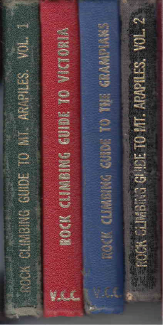
50 | BWA June 2021
The only sleeping mat I can find in this guide that is in use today is a Thermarest, 119 X 48 cm, 673 grams. Today the equivalent Thermarest is 3-400 grams. The range has been vastly expanded.
Mountaineering and ski touring1967 – FMC Basic instruction manualThis small booklet of 32 pages was produced by the Federated Mountain Clubs of New Zealand. The start of the book has a sentence "It must be emphasised that real competence can only be gained from experience." That has not changed.
Two pages later is advice about karabiners: "Use only steel. Other types of light alloy karabiners have no place for the uses described in these notes." When I first started climbing we used steel, soon abandoned as lighter krabs became common. I have a steel Bonatti, weight 200 grams. The lightest modern krabs weigh 20-30 grams. "Slings should be made of manilla or hemp about 5/16" minimum diameter." The book predates harnesses and says that a waist loop should be used. This is one reason for the saying that the leader should never fall; falling was painful and risky.
1973 – Mountain 25This was a UK magazine similar to Wild, published by YHA England and Wales, and was probably the leading international mountaineering magazine of its time. New alpine and rock routes include places all over the world, with an emphasis on the UK. The presentation and information are excellent with pictures that made many dream.
Galen Rowell reviews the widely published mountaineering cartoonist Sheridan Anderson.
1974 – Summit volume 20, number 10This is described in Mountain as "the most venerable and successful of American mountain magazines." Apart from the usual fare, two parts stand out. The first is how to dig a snow cave with a new method. Briefly, on a steep snow bank go in and up. The excavated snow falls down the slope. A report of a climb on Peak Lenin details the deaths of nine climbers from cold on the normal routes of an easy mountain. "Perhaps an important factor in the death of the Russian women was the false sense of confidence afforded by radios, helicopters, expert advisers at base camp and large numbers of people on the same route." This pre-dates mobile phones, electronic maps, GPSs, PLBs and the internet.
1979 – Mountaineering 79This is the journal of the Melbourne University Mountaineering Club. In Melbourne, Paddy Pallin was at 55 Hardware Street. Moloneys and Bushgear were trading. In 2021 Auski are still at the same place,
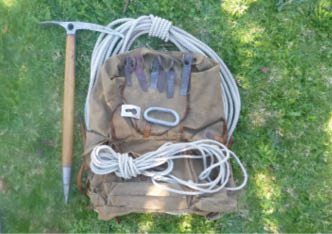
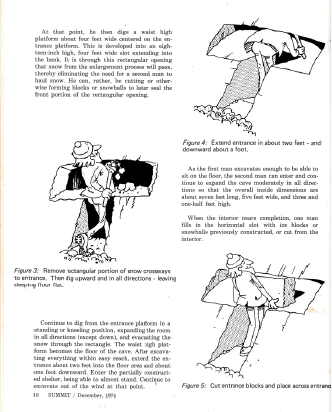
Summit magazine, how to build a snow cave
Chouinard ice axe, pitons, bolt hanger, Bonatti krab, 60' number 3 rope, bamboo A-frame pack and a waist cord
BWA June 2021 | 51

trading since 1949. Ansett have a full page advertisement. Bill Bewsher's account of a 1948 attempt at Federation is stunning in that so much of the gear is well below today's standards. Mike Feller details the rise in visitor numbers in Victoria and Kosciuszko. Federation Hut has 723 and 1445 visitors for 1970 and 1977. I suspect that the numbers are now much higher, but with just 10-20% of people making a log book entry it's hard to say. The next page has a picture I took of Glen Tempest on Judgement day at Arapiles. I'd forgotten about that! Rob Jung discusses the proposed Snowy River National Park, now part of the Alpine NP.
The back page is an advertisement for Bushgear with a quote from Eric Shipton in Upon That Mountain, 1943.
He is lucky who, in the full tide of life, has experienced a measure of the active environment he most desires. In these days of upheaval and violent change, when the basic values of to-day are the vain and shattered dreams of to-morrow, there is much to be said for a philosophy which aims at living a full life while the opportunity offers. There are few treasures of more lasting worth than the experience of a way of life that is in itself wholly satisfying. Such, after all, are the only possessions of which no fate, no cosmic catastrophe can deprive us; nothing can alter the fact if for one moment in eternity we have really lived.
1984 – New Zealand Alpine JournalThis is published by the New Zealand Alpine Club. As I read the pages for the first time in decades I was taken back to the mountains I loved so much. Alpine starts, firm snow, crampons, the joy of summits offset by terror as the slope collapsed.
1986 – Ski touring in Victoria 10 years down the trackThis is the monthly newsletter of the Ski Touring Association of Victoria, and is an anniversary edition. STAV made a big difference to XC skiing and conservation. In 1976 there was a lot of emphasis on resort-based XC skiing activities and marked trails. With other groups, STAV opposed the proposals for a resort on Feathertop (does this sound familiar?), a new village at
Rocky Valley Dam, ski tows and helicopters on Mount Nelse, and recreational use of snowmobiles in remote regions. The snowmobiles were sometimes cited as being on a search and rescue practice, but this was a small fig leaf covering riders having fun. Instruction and safety standards were raised. Zoning was developed. Huts, routes and pole lines were discussed. The Mount Stirling development was opposed.
It was a busy time in the face of vested interests and a lack of awareness of conservation values. National parks were under threat from developers, helicopters landed at remote places without permission and nothing was done by land managers. Not much has changed.
Bindings are three pin, waxes are in evidence, and a party stayed at the Soil Conservation Hut above Blue Lake on the Main Range at KNP.
Bushwalking magazines 1965 – Walk This is the annual magazine of the Melbourne Bushwalkers. The inside cover has an advertisement for Paddy Pallin with an A-frame pack. Opposite is the meeting room,
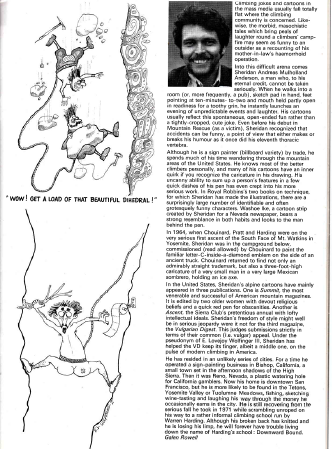
Sheridan cartoons in Mountain 25
52 | BWA June 2021
VRI, the same building as YHA Bushies a few years later. Page 23 has advice:
Culled from a South African newspaper: "It is not true that walking is a lost art. After all, one has to get to the garage somehow."
There's a picture of a beginner abseiling, bare feet, T-shirt, rope over the shoulder – ouch. Surely twisted krab or crossed krabs had been invented by then. The Forests Commission of Victoria has a full page advertisement showing how to safely light fires and to put them out, lots of water. A possible chair lift up Mount Bogong is discussed. "Hundreds of snow poles have been erected on the Bogong High Plains lately which should considerably help those who have taken to ski touring as an extension of walking." The Victorian Government Tourist Bureau has a page advising that "Special tickets enable hikers to leave Melbourne on one line, walk across country to join a return train on another line." Maps are 1:63,360, one inch to the mile, with currency in pounds, shillings and pence. The last page has snake bite treatment – cut the wound. We’ve come a long way since then.
1971 – The Melbourne walker This is similar in size and style to Walk, and is the annual of the Melbourne Amateur Walking and Touring Club, now called the Melbourne Walking Club. An advertisement has sleeping bags from $4.95, one man tents for $8.00, compasses from 25 cents, and Flinders Ranges H-frame packs for $24. The Scout Shop has eight outlets in Victoria. The Australian Dairy Produce Board has a full page advertisement with dietary suggestions. Kodak has an Instamatic camera, not quite a Nikon or Canon, but it works.
"Most people would accept that the history of the Grampians commenced with their discovery by the famous Major Thomas Mitchell." Today a more enlightened view has Aboriginals there for tens of thousands of years. A new concept is discussed – if you can carry it in you can carry it out, with the main emphasis on cans. The custom until then was burn, bash and bury.
1972 – Walk Kodak has an advertisement for a cassette camera, thus avoiding the need to feed the film. The Kimptons Mountain Mule is 2 lbs 14 ounces, or 1.3 kg, quite light for an H-frame pack of that era. R Johnson is Dick Johnson, see below. He discusses fire in the forest environment and says that there's a new technique, "fuel reduction" or "prescribed burning". Some 48 years later the article is still valid.
The Gilleo Memorial Track has just been cut. The Alpine Trail is now called the Alpine Track. The Ministry of Tourism will maintain essential Bogong High Plains pole lines. The Kosciuszko Huts Association has been formed. The National Fitness Council is running bushwalking leader training courses. This is before the Bushwalking and Mountaincraft Leadership Course was created.
1974 – The Tasmanian trampThis is the Journal of the Hobart Walking Club and was produced every two years. The format is the same as the two Melbourne clubs above. The first thing that made me take note were the authors of the articles – Jesse Luckman, Reg Williams, Jack Thwaites, Alex Sklenica and Jim England.
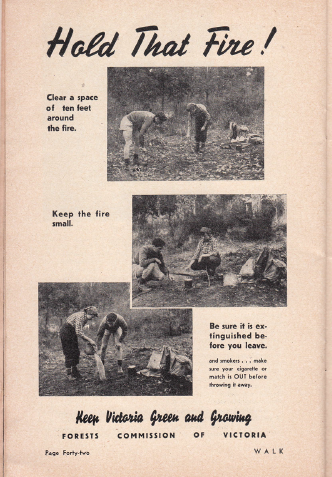
Walk 1965
BWA June 2021 | 53
Jesse discusses conservation and says "Frequently, members have collated material and presented evidence on behalf of the Club to members of Parliament, select committees, and boards of enquiry". Fourteen years later I was doing just that regarding the Alpine National Park. "The first private air drop in the South-West was made in 1946." The article is too long to quote, but it would be good if Jesse's ideas of 1974 were adopted; it would have saved a lot of aggro regarding many areas, including Halls Island.
Supplies for an Easter camp in 1924 are cited: 16 lb bread, 2 lb sugar, 24 eggs, 1 cake, 2 large jars of jam, 1 large apple pie, 1 small apple pie, and 1 large rabbit pie. Items were on the big side. Tracks have been cut to Cape Pillar and Clemes Peak. I wonder what they would think of the upmarket Two Capes track.
Guide books1974 – Bushwalking in the Victorian AlpsThis was first published in 1970 by the Melbourne University Mountaineering Club as Guide to the Victorian Alps, filling an
information void. The 1974 update had a new name and revised notes. Cowombat Flat is spelled as Quambatt Flat in the book. Summit Hut on Bogong is still up; it would be intentionally burnt a few years later.
There's advice that entry to old mines at Walhalla is "extremely dangerous, and should not be undertaken without an experienced guide." I discovered this. On an exploration trip we had gone in horizontally a short distance, past a fallen roof, and for some reason that we could not initially fathom the candles kept on going out. Then we all got headaches. I was the first to see the danger and said something like, "There seems to be a lack of oxygen. What steps should we take?" My mate Terry Elliott gave a reply that was typical for him: "Bloody big ones!" We were in bad shape when we emerged, but recovered to do more foolish things.
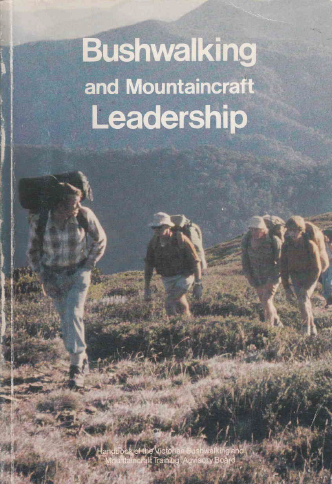
Bushwalking and Mountaincraft Leadership, 1981
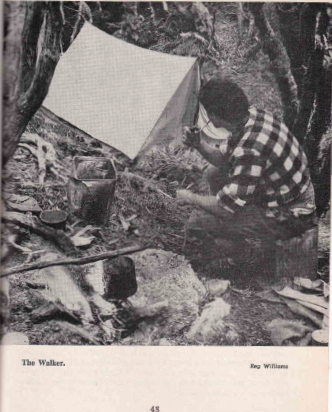
Tasmanian Tramp 1974. Note the fire, trees very close, food drop, tiny tent held up with sticks and the pipe.
“What steps should we take?" My mate Terry Elliott gave a reply that was typical for him: "Bloody big ones!"
54 | BWA June 2021
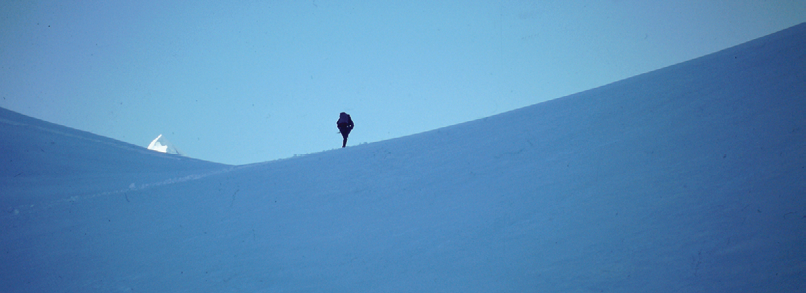
Instruction1981 – Bushwalking and Mountaincraft LeadershipThis was first published by the Victorian Department of Sport and Recreation as the handbook of the Victorian Bushwalking and Mountaincraft Training Advisory Board in 1978. It proved to be popular and a revised edition was published in 1981. It has been revised again, and in my view is one of the best leadership resources in Australia. A lot has changed in 40 years. Oiled japara, H-frame packs, japara ridge tents, campfires, technology, information, bushwalking clubs, climate change, logging. The core information about leadership is intact. I contributed in a minor way to the 1978 and 2000 editions and was a staff member.
Writing in 2004, former BMTAB Executive Officer Rod Lingard has this to say.
In his endorsement of the latest edition, the chair of the Outdoor Recreation Council of Australia said: “It is regarded as the definitive text for leading others in outdoor pursuits ...” Schools, universities and other groups throughout Australia have bought the book in impressive numbers. More than 30,000 copies have been sold.
A bushwalking manual based on the BMLC book can be found here.
Conservation1974 – Alps at the crossroadsThis was written by Dick Johnson and published by the Victorian National Parks Association to push for an Alpine National Park. Alps at the crossroads is one of the most important conservation books in Victoria, if not Australia. The reader is gently taken through the history, geology
flora, fauna, grazing, recreation and other aspects. The facts are stated simply, and it's very persuasive. Forty-seven years since publication the words still stand true.
1979 – The South West Book, a Tasmanian WildernessThe Australian Conservation Foundation published this lovely book. The format is similar to Alps at the crossroads. There are pictures of Lake Peddar, the real one, not the new one. We lost that, going down fighting, the victim of Tasmanian government foolishness. Bob Hawke saved the Franklin, with such issues leading to the rise of conservation groups. The fight continues at Halls Island, the Bogong High Plains and too many other places.
1983 – Franklin blockadePublished by The Wilderness Society, the blockaders' stories give a wonderful view of events without the filter of others. Labor won the federal election on 11 March 1983. Prime Minister-elect Bob Hawke's first commitment on election night was "The dam will not be built." A few pages later is this: "On 1 July 1983 the High Court of Australia ruled that the Commonwealth Government had the power to stop the Gordon-below Franklin dam."
All that protesting paid off. Those who were involved should still be proud that they were there.
Final thoughtsWith increasing reliance on electronic information, I wonder if an article such as this will be possible in 50 years. Someone else can write it.
Cinerama Col, New Zealand
BWA June 2021 | 55